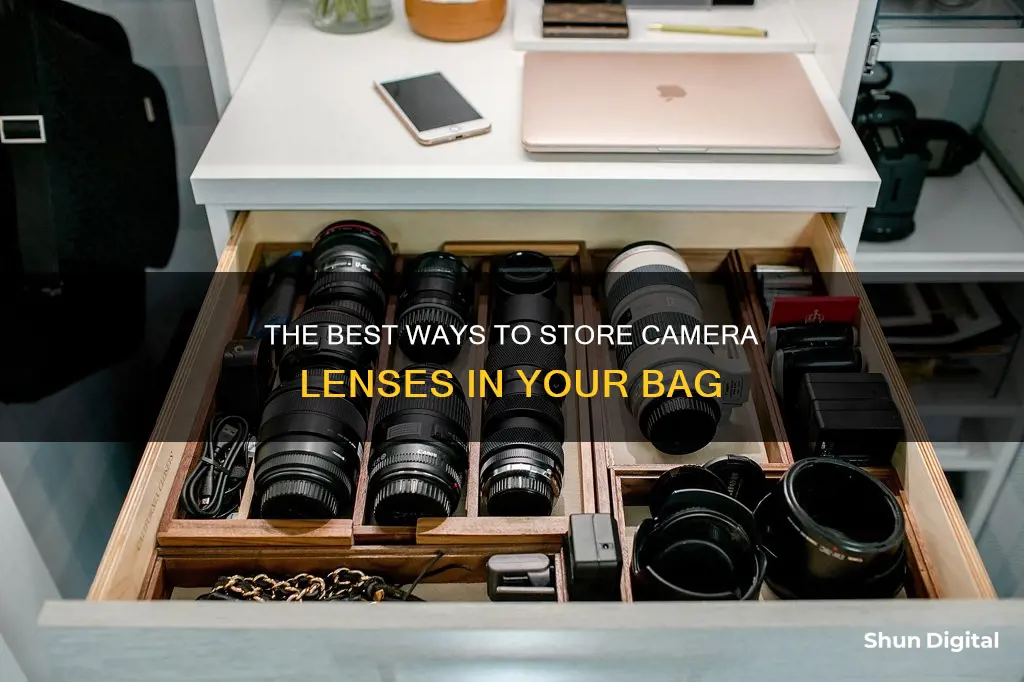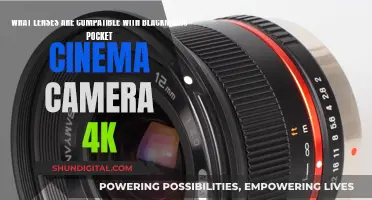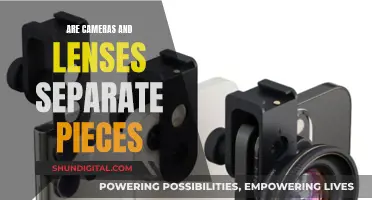
Camera lenses are delicate pieces of equipment that require careful storage to ensure their longevity and optimal performance. Here are some essential tips on how to store camera lenses in a bag:
- Use Lens Caps and Filters for Protection: Attach lens caps to both ends of the lens to protect the lens elements from dust, dirt, and scratches. Additionally, consider using UV filters, which not only protect against physical damage but also reduce ultraviolet light effects.
- Proper Positioning: Keep lenses upright in the bag with the lens mount facing upwards. This distributes weight evenly and prevents unnecessary pressure on the lens elements. It also reduces the risk of accidental impact and makes lens retrieval easier.
- Provide Cushioning with Lens Pouches or Dividers: Use lens pouches made of soft, padded material to protect lenses from scratches and minor impacts. Dividers, made of foam or padded material, help organise and separate lenses, creating individual compartments to prevent lenses from knocking against each other.
- Temperature Control: Store lenses in a bag that provides insulation to protect against extreme heat or cold, which can cause lens elements to expand or condensation to form. Keep the bag in a cool, dry place, away from direct sunlight or heat sources.
- Use a High-Quality Camera Bag: Invest in a camera bag with adequate padding, compartments, and dividers specifically designed for camera gear. This will ensure your lenses are secure and protected during transportation.
- Avoid Sharp Objects and Heavy Equipment: Keep lenses away from sharp objects and other heavy equipment in your bag to prevent potential damage.
- Keep Lenses Dry: Allow lenses to acclimate to room temperature before use, especially if bringing them indoors from a cold environment, to prevent moisture damage.
| Characteristics | Values |
|---|---|
| Lens protection | Use lens caps and filters for storage |
| Proper positioning | Keep lenses upright |
| Padding | Use lens pouches or dividers to provide cushioning |
| Temperature control | Avoid extreme heat or cold environments |
What You'll Learn
- Use lens caps to protect your lens from dust and scratches
- Store lenses in an upright position to prevent damage
- Use lens pouches or dividers for added cushioning and protection
- Control temperature and avoid extreme heat or cold to maintain lens performance
- Use filters for added protection and to reduce UV light effects

Use lens caps to protect your lens from dust and scratches
Lens caps are an essential component of lens protection. They are small, fiddly, and easy to lose, but they play a crucial role in shielding your camera lens from scratches and bumps. Lens caps should be kept on your lenses at all times when they are not in use, such as when they are stored in a camera bag.
The lens cap that came with your camera might be sufficient, but it is worth considering investing in a backup or a sturdier option. It is recommended to have both front and rear lens caps to protect your lens from dust and scratches effectively.
- Always keep your lens caps on when the camera is not in use.
- Consider investing in a sturdy lens cap that fits your camera model well.
- Use both front and rear lens caps for maximum protection.
- Keep your lens caps clean and free of dust and fingerprints.
- Store your lens caps in a safe place when not in use to avoid losing them.
Mirror Lenses: Unique Reflections in Camera Optics
You may want to see also

Store lenses in an upright position to prevent damage
When storing camera lenses in a bag, it is important to ensure they are kept in an upright position to prevent any potential damage. Here are some detailed guidelines to help you achieve this:
Use Lens Caps and Filters for Protection
Lens caps are essential for protecting your lenses from dust, dirt, and scratches. Make sure to attach lens caps to both ends of the lens when storing it in your bag. Additionally, consider using UV filters, which not only protect against physical damage but also reduce the effects of ultraviolet light. These filters can be left on the lens even when it's not in use, providing an extra layer of protection.
Store Lenses Upright
Always store your lenses in an upright position with the lens mount facing upwards. This helps distribute the weight evenly and prevents any unnecessary pressure on the lens elements. Placing them upright also reduces the risk of accidental impact or knocking against other items in your bag. Upright storage also allows for easier access and retrieval when you need to switch lenses quickly.
Use Lens Pouches or Dividers for Cushioning
Lens pouches provide an extra layer of protection and are designed to keep lenses safe from scratches, dust, and minor impacts. They are usually made of soft, padded material and offer a snug fit for your lenses. Dividers, on the other hand, are adjustable and help separate lenses within your bag, preventing them from rubbing against each other and causing damage.
Choose a Bag with Adequate Padding and Compartments
Invest in a high-quality camera bag with padded compartments or dividers specifically designed for lens storage. Look for bags with customizable dividers that allow you to create separate compartments for each lens, ensuring they are secure and protected. This will also help regulate temperature and protect your lenses from sudden changes in temperature.
Avoid Extreme Temperatures
Avoid storing your camera lenses in extreme heat or cold environments as they can cause damage. High temperatures can cause lens elements to expand and potentially lead to misalignment or distortion. Instead, store your bag in a cool, dry place, away from direct sunlight or heat sources. Similarly, extreme cold can cause condensation to form on lens surfaces when exposed to warmer environments. Allow your lenses to gradually acclimate to room temperature before use to prevent moisture damage.
Lenses for Full-Frame Cameras: What's the Difference?
You may want to see also

Use lens pouches or dividers for added cushioning and protection
When storing camera lenses in a bag, it is essential to use lens pouches or dividers to provide added cushioning and protection. These accessories act as a barrier against scratches, dust, and minor impacts, ensuring your lenses remain in pristine condition.
Lens pouches are typically made of soft, padded material and offer a snug fit for each lens. They are available in various sizes to accommodate different lens types and can be conveniently stored within your camera bag. Some lens pouches feature drawstring closures or belt loops, providing added security and portability.
Dividers, on the other hand, are excellent for organising and separating lenses within your bag. Made from foam or padded material, they can be adjusted to fit various lens sizes. By creating individual compartments, dividers prevent lenses from rubbing against each other and causing potential damage. They also provide an extra layer of protection against external shocks or movements during transportation.
When using lens pouches or dividers, it is important to consider the overall organisation of your camera bag. Place larger, heavier lenses at the bottom and lighter ones on top to distribute weight evenly and avoid putting unnecessary pressure on the lenses. Additionally, keep the lenses in an upright position to prevent them from rolling around and colliding with each other.
For maximum protection, consider investing in a specialised lens case. These cases are designed with hard exteriors, customisable foam interiors, and even waterproof capabilities, offering the highest level of protection for your valuable lenses.
Camera Lenses: Weatherproof or Not?
You may want to see also

Control temperature and avoid extreme heat or cold to maintain lens performance
When storing camera lenses in a bag, controlling the temperature is crucial to maintaining optimal lens performance and longevity. Extreme heat or cold can cause damage to your lenses, so it is important to take the necessary precautions to protect your valuable equipment. Here are some tips to control the temperature and avoid extreme conditions:
- Insulation: Choose a camera bag that provides insulation to regulate temperature changes. Look for bags with padding or compartments specifically designed for lens storage.
- Avoid Extreme Heat: High temperatures can cause lens elements to expand, leading to misalignment or distortion. Store your bag in a cool, dry place away from direct sunlight or heat sources.
- Prevent Condensation: Condensation can form on lens surfaces when moving between cold and warm environments, leading to moisture damage. Allow lenses to gradually adjust to room temperature before use by keeping the bag closed for some time after bringing it indoors.
- Avoid Extreme Cold: Cold temperatures can also be detrimental. Water vapour can condense on cold lens surfaces, causing lens coatings to deteriorate and optics to fog up.
- Lens Coatings: Modern lens coatings can better withstand temperature variations. However, it is still important to follow general guidelines for lens storage to ensure longevity.
- Dry Cabinets: Consider investing in a dry cabinet, which regulates humidity levels and provides an ideal storage solution for lenses, especially in humid climates.
- Desiccants: Use desiccants like silica gel packets to absorb moisture and protect your lenses from mould and mildew.
- Avoid Direct Sunlight: Do not leave your camera bag in direct sunlight, as this can cause the bag and its contents to heat up quickly.
- Car Storage: Avoid leaving your camera gear in a hot car. If necessary, place the equipment in a cooler without ice to provide some protection from overheating.
Keeping Camera Lenses: Tips for Longevity and Performance
You may want to see also

Use filters for added protection and to reduce UV light effects
Filters can be used to protect your camera lens from damage and reduce the effects of UV light. They are attached to the front of a camera lens and are particularly useful when shooting film photography. Film stock is more sensitive to UV light, which can cause blue discolouration in photos.
Digital cameras are less sensitive to UV light, but digital photographers still use filters as protection for the frontal elements of their lenses. Filters can protect your lens from scratches, dust, liquids, and other hazards. They are also easily removable, making them much easier to clean.
However, the addition of another glass element can cause unwanted flares when shooting directly at a light source. This can result in a loss of image quality, although the difference is usually minimal and can be fixed in editing.
Overall, the use of filters depends on your shooting environment and priorities. If you are in an environment with potential hazards, such as dust or water particles, a filter can provide added protection for your lens. On the other hand, if image quality is a higher priority, you may choose to forego the filter to avoid any potential reduction in image quality.
The Camera Power of Note 10
You may want to see also
Frequently asked questions
Proper storage of camera lenses is crucial to protect them from damage caused by humidity, water, chemicals, dust, sand, dirt, and extreme weather conditions. These elements can negatively impact the optical integrity and image resolution of the lenses.
Storing lenses in a camera bag for several months without use may carry the risk of mould or fungal growth, especially if the bag is made of natural materials that absorb moisture and the lenses are not kept in a controlled environment.
It is recommended to use lens caps on both ends of the lens and to store the lenses in a designated lens pouch or case within the bag. The lens pouch provides extra cushioning and protection from scratches and minor impacts.
Lenses should be stored upright, with the lens mount facing upwards, to distribute weight evenly and prevent unnecessary pressure on the lens elements. This positioning also makes it easier to access and switch lenses when needed.
Look for camera bags with padded compartments or dividers that provide extra protection and prevent lenses from knocking against each other. Bags with customisable dividers are ideal, as they allow you to create separate compartments for each lens, ensuring they remain secure and don't move around during transportation.







